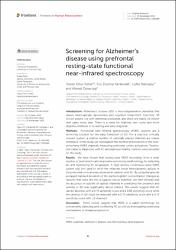| dc.contributor.author | Keleş, Hasan Onur | |
| dc.contributor.author | Karakulak, Ece Zeynep | |
| dc.contributor.author | Hanoğlu, Lütfü | |
| dc.contributor.author | Omurtag, Ahmet | |
| dc.date.accessioned | 2022-12-26T08:43:27Z | |
| dc.date.available | 2022-12-26T08:43:27Z | |
| dc.date.issued | 2022 | en_US |
| dc.identifier.citation | Keleş, H. O., Karakulak, E. Z., Hanoğlu, L. ve Omurtag, A. (2022). Screening for Alzheimer's disease using prefrontal resting-state functional near-infrared spectroscopy. Frontiers in Human Neuroscience, 16. https://doi.org/10.3389/fnhum.2022.1061668 | en_US |
| dc.identifier.issn | 1662-5161 | |
| dc.identifier.uri | https://doi.org/10.3389/fnhum.2022.1061668 | |
| dc.identifier.uri | https://hdl.handle.net/20.500.12511/10182 | |
| dc.description.abstract | IntroductionAlzheimer's disease (AD) is neurodegenerative dementia that causes neurovascular dysfunction and cognitive impairment. Currently, 50 million people live with dementia worldwide, and there are nearly 10 million new cases every year. There is a need for relatively less costly and more objective methods of screening and early diagnosis. MethodsFunctional near-infrared spectroscopy (fNIRS) systems are a promising solution for the early Detection of AD. For a practical clinically relevant system, a smaller number of optimally placed channels are clearly preferable. In this study, we investigated the number and locations of the best-performing fNIRS channels measuring prefrontal cortex activations. Twenty-one subjects diagnosed with AD and eighteen healthy controls were recruited for the study. ResultsWe have shown that resting-state fNIRS recordings from a small number of prefrontal locations provide a promising methodology for detecting AD and monitoring its progression. A high-density continuous-wave fNIRS system was first used to verify the relatively lower hemodynamic activity in the prefrontal cortical areas observed in patients with AD. By using the episode averaged standard deviation of the oxyhemoglobin concentration changes as features that were fed into a Support Vector Machine; we then showed that the accuracy of subsets of optical channels in predicting the presence and severity of AD was significantly above chance. The results suggest that AD can be detected with a 0.76 sensitivity score and a 0.68 specificity score while the severity of AD could be detected with a 0.75 sensitivity score and a 0.72 specificity score with <= 5 channels. DiscussionThese scores suggest that fNIRS is a viable technology for conveniently detecting and monitoring AD as well as investigating underlying mechanisms of disease progression. | en_US |
| dc.language.iso | eng | en_US |
| dc.publisher | Frontiers Media S.A. | en_US |
| dc.rights | info:eu-repo/semantics/openAccess | en_US |
| dc.rights | Attribution 4.0 International | * |
| dc.rights.uri | https://creativecommons.org/licenses/by/4.0/ | * |
| dc.subject | fNIRS | en_US |
| dc.subject | Cognitive | en_US |
| dc.subject | Alzheimer’s Disease | en_US |
| dc.subject | Machine Learning | en_US |
| dc.subject | Early Diagnosis | en_US |
| dc.title | Screening for Alzheimer's disease using prefrontal resting-state functional near-infrared spectroscopy | en_US |
| dc.type | article | en_US |
| dc.relation.ispartof | Frontiers in Human Neuroscience | en_US |
| dc.department | İstanbul Medipol Üniversitesi, Tıp Fakültesi, Dahili Tıp Bilimleri Bölümü, Nöroloji Ana Bilim Dalı | en_US |
| dc.authorid | 0000-0003-4292-5717 | en_US |
| dc.identifier.volume | 16 | en_US |
| dc.relation.publicationcategory | Makale - Uluslararası Hakemli Dergi - Kurum Öğretim Elemanı | en_US |
| dc.identifier.doi | 10.3389/fnhum.2022.1061668 | en_US |
| dc.institutionauthor | Hanoğlu, Lütfü | |
| dc.identifier.wosquality | Q2 | en_US |
| dc.identifier.wos | 000895972900001 | en_US |
| dc.identifier.scopus | 2-s2.0-85144036615 | en_US |
| dc.identifier.pmid | 36518566 | en_US |
| dc.identifier.scopusquality | Q2 | en_US |



















